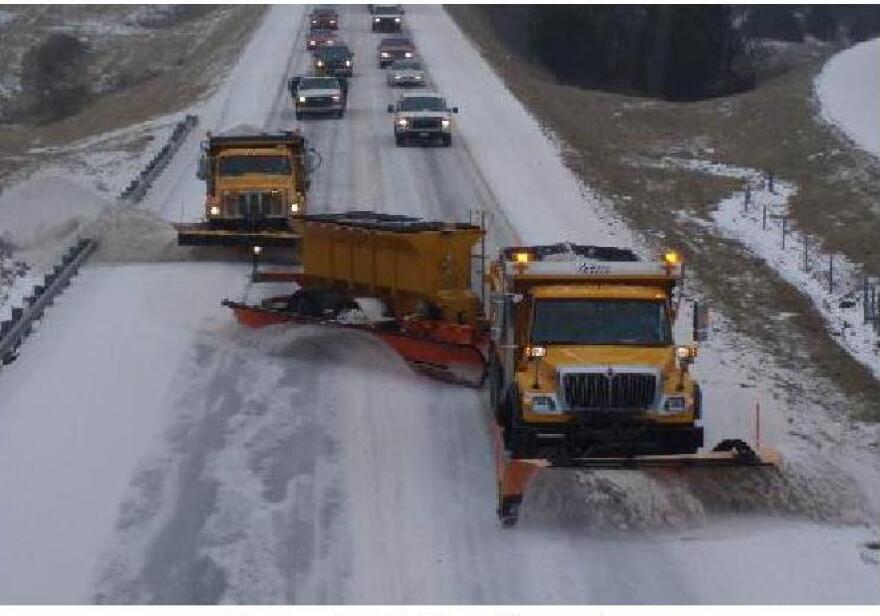A snowier-than-average winter and four consecutive years of budget cuts and have stretched the state Department of Transportation’s ability to plow state roads to the limit. Department Commissioner Marc Luiken says that’s forced him and his workers to come up with more efficient ways to get the job done.
Greg Garrels says he was plowing his driveway off Johnson Road in Salcha a couple of weekends ago when he noticed the school bus turnaround spot had not yet been cleared of snow dumped by the last winter storm that blew through.
“So I went down and cleaned out the bus turnout – which was no fun,” he said, “because there was about a foot-and-a-half of hardpack in there. Y’know – concrete?”
Garrels says he’s noticed state Department of Transportation crews have sometimes been slow to plow some of the roads around Salcha this year. He thinks that’s mainly due to DOT’s closure of the Birch Lake maintenance station, which used to take care of snow plowing around the community. The Birch Lake station was among five the department shut down last year to absorb cuts in the agency’s operations and maintenance budget, which took a $43 million hit in fiscal 2017.
“They’re really trying hard, y’know, but the thing is there’s only so much they can do with fewer pieces of equipment and fewer people,” Garrels said.
State Transportation Commissioner Marc Luiken concedes that reductions in DOT’s budget over the past four years have reduced the department’s ability to quickly clear snow and ice from Alaska’s roads. He says last year’s $43 million reduction equates to nearly a quarter of the agency’s operations and maintenance budget.
“That has significantly impacted how well we are able to maintain our road system – not just winter maintenance, but really summer maintenance,” he said. “But certainly, people see it more acutely during the winter, when people see snow and ice on the roads.”

Luiken said in an interview Monday that this year’s heavy snows have compounded the problem. National Weather Service meteorologist Chris Cox says last month the Fairbanks area got nearly 23-and-a-half inches of snow.
“That was the sixth-snowiest February of the last 107 years,” Cox said. “For the season total, we’ve had 77-and-a-half inches of snow. And that’s 19-point-2 inches above the normal.”
Luiken says the tight budget has forced his agency to look for ways to get the job done with less money and fewer workers.
“I think we’ve found more efficient ways to deal with snow and ice,” he said.
Transportation Department spokeswoman Meadow Bailey says those would include “things like ice-breakers that you’ll see around town, especially when we have icy (road) surfaces.”
Bailey says the ice-breaking trucks push a cylindrical drum with spikes to bust up the ice, which is then scraped up a snowplow that follows close behind. Bailey says the department also has been using tow plows, which are pulled behind snowplows.
“We’re also using tow plows,” she said, “so we can use one truck to clear two lanes with one operator.”

Bailey says clearing all this year’s snow from the state’s roads has required crews to log about a million dollars in overtime. She says about $600,000 of that has gone to workers in DOT’s Northern Region, where 60 percent of the state’s roadways are located. She says DOT is trying to save money in other ways, such as using a salty brine to de-ice roads, to make it go farther than just applying salt. And she says the department is using more pickup-truck-size snowplows for smaller outlying roads.
“It was taking us a while to get to some of these roads and we wanted to try and respond faster,” she said. “and this is one of the things that we’re experimenting with this year. And we’ve had good response with it.”
She says the department will continue using the more efficient equipment and strategies – even after Alaska’s fiscal crisis passes and the state is able to restore funding to its agencies.
Editor's Note: Transportation Department officials recommend motorists check road conditions by going to 511.alaska.gov before embarking on a road trip to check on road conditions.



